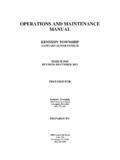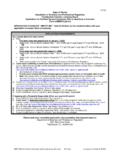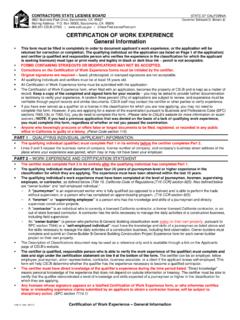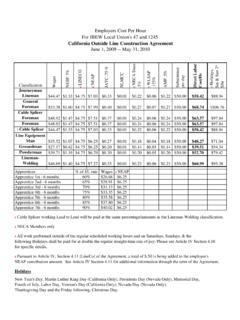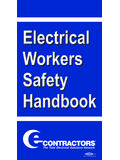Transcription of DISASTER PREPAREDNESS BY LOCAL …
1 1 DISASTER PREPAREDNESS BY LOCAL government : A CASE STUDY OF foreman AND KENNEDY ROAD INFORMAL SETTLEMENTS IN THE ETHEKWINI MUNICIPALITY Bethuel Sibongiseni Ngcamu Mangosuthu University of Technology-Department of Human Resource and Development Dr. N. Dorasamy Durban University of Technology-Department of Public Management and Economics ABSTRACT DISASTER PREPAREDNESS is one of the phases within the DISASTER management cycle which covers implementation or operation, early warning systems and capacity building so that the population can react appropriately when an early warning is issued. Disasters have inflicted a heavy cost on human, material and physical resources. A comprehensive review of the literature has revealed that the development of DISASTER management strategies, such as PREPAREDNESS , must be undertaken before the event strikes.
2 The purpose of the article is to contribute to the development of a robust DISASTER management policy and the centre within the eThekwini municipality. Furthermore, this article intends to enable the DISASTER management department within the municipality to function effectively and efficiently by applying new strategies for DISASTER PREPAREDNESS and to add value to the body of knowledge in South Africa as there are a limited number of researchers who have contributed to the study of DISASTER rmanagement. The research was undertaken at the foreman and Kennedy Road informal settlements located in Clare Estate, under Ward 25, in Durban. Questionnaires were self-administered to a population size of 220 respondents from which a sample size of 140 respondents completed the questionnaires, thereby generating a response rate of Interviews were also conducted with municipality officials involved in DISASTER management.
3 There are two categories of data collected that include biographical profiles (age, gender, marital status, education, occupation, income, number of children, race and tenure) and DISASTER PREPAREDNESS . Data was analysed in the form of frequency distribution and cross-tabulation tables. 2 INTRODUCTION Developing countries, such as South Africa, have often failed to implement DISASTER management strategies such as PREPAREDNESS . Political neglect, social marginalization and limited access to resources compel helpless people to live and work in hazard-prone areas. Drawing on cases from the developing world, scholars such as O Keefe, Westgate & Wisner (1976:45), Hewitt (1983:45) and Wisner, Blaikie, Cannon & Davis (2004:65) argue that people s behaviour in the face of natural hazards is constrained by social, economic and political forces rather than individual risk perception.
4 government is accountable to citizens for quality service delivery such as housing provision. The Constitution of the Republic of South Africa, 1996 (chapter 7:152), requires LOCAL government as a sphere of government to provide democratic and accountable government to LOCAL communities, ensure the provision of services to communities in a sustainable manner, promote social and economic development, promote a safe and healthy environment; and encourage communities and community organisations in matters of LOCAL government (Armstrong, 2005:2). government accountability to all citizens translates to improving the lives of the poor and the vulnerable. LOCAL governments require the assistance of structures involving all DISASTER practitioners and specialists dedicated to monitoring and improving DISASTER PREPAREDNESS approaches.
5 The foreman and Kennedy Road informal settlements are prone to emergencies and disasters such as floods, fires and storm surges which negatively impact on people living in these vulnerable areas. International experiences of disasters depict that different countries are struck by floods, earthquakes and volcanoes. International declarations and proposals by the United Nations Development Programme and other organisations dealing with DISASTER risk reduction plays a tremendous role in DISASTER PREPAREDNESS . Furthermore, the role of non-governmental organisations (NGOs), such as the International Red Cross and the role played by the United States of America (USA) in DISASTER PREPAREDNESS , assist countries struck by catastrophies with PREPAREDNESS strategies.
6 If DISASTER frequency is to be reduced, then safety must also be sought as a major goal in comprehensive strategic planning to reduce disasters. DISASTER identification and reduction at an international level and national level must be supplemented by LOCAL activities. The Centre for Research on the Epidemiology of Disasters (2006:1) states that, DISASTER PREPAREDNESS often fails because it is rarely evidence based. It suggested that more scientific studies are needed to improve the effectiveness of DISASTER PREPAREDNESS and prevention. Some disasters can be avoided and 3 minimized through enhancing the national DISASTER management capacities to address the various aspects of prevention, PREPAREDNESS , mitigation, response, rehabilitation and recovery.
7 Holloway (2003:34) argues that DISASTER risk reduction is the systematic development and application of policies, strategies and practices to minimise vulnerabilities and DISASTER risks throughout society to avoid (prevent) or limit (mitigate and be prepared for) the adverse impact of hazards, within the broad context of sustainable development. Haddow & Bullock (2006:167) emphasise that there are three sets of actions that can reduce losses. These actions are hazard mitigation, emergency PREPAREDNESS and recovery PREPAREDNESS practices. This article seeks to investigate DISASTER PREPAREDNESS within eThekwini Municipality. The fragmented management of DISASTER actions such as PREPAREDNESS has contributed to unnecessary morbidity, mortality, and a waste of resources.
8 However, some disasters can be avoided and minimised by enhancing the national DISASTER management capacities to address the various aspects of PREPAREDNESS . Informal settlement growth in metropolitan areas of South Africa has increased in the past decade as a result of the abolishing of legislation implemented by the apartheid government that prevented urbanisation (Ferreira, de Meyer, Loots & Keyise, 2002:23). The article will explore whether DISASTER PREPAREDNESS strategies are adequately implemented in informal settlements with the aim to avoid, prevent and mitigate the impacts of disasters. Previously, PREPAREDNESS strategies were ignored because DISASTER management was responding to and recovering from the DISASTER impact as disasters were governed by reacting Civil Protection Act 67 of 1977 and the Fundraising Act 107 of 1978.
9 Thus, with the enactment of the DISASTER Management Act 57 of 2002, DISASTER PREPAREDNESS ensures that appropriate systems, procedures and resources are in place to provide effective assistance to DISASTER victims, thus facilitating relief measures and rehabilitation services. The focus of DISASTER management is to reduce the risk posed by actual and potential hazards. Hazards can be broadly grouped into three areas such as natural, technological and complex emergencies (Alexander, 2002b). Global approach to DISASTER management DISASTER management strategies are traced back to antiquity when early hieroglyphics depict cavemen trying to deal with disasters. The Holy Bible speaks of the many disasters that hindered civilisations.
10 Haddow and Bullock (2006:1) mention the account of Moses parting the Red Sea which can be interpreted as the first attempt at flood control. Genesis 6 verse 14 (Zodhiates, Baker and Kemp, 1996: 10) speaks about Noah and the Ark, when he built an ark from cypress wood, coated it with pitch inside and out, 4 as a mitigation strategy for the forthcoming predicted floodwaters. Moreover, the holy Bible speaks of many disasters that hindered civilisations. Early DISASTER management strategies include inter alia, the promulgation of the United State of America (USA) Congressional Act of 1803 which was passed to provide financial assistance to a New Hampshire town that had been devastated by fires (Haddow et al., 2006:2). Another notable example is that of the cold war era where the nuclear war was seen as a potential DISASTER threat.







